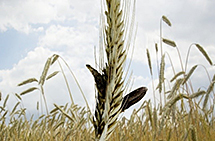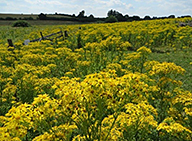Health Risk Assessment of Mycotoxins and Plant Toxins in Food
|
Ergot (Clviceps purpurea) |
Ragwort (Jacobaea vulgaris) |
Mycotoxins (mould toxins) and plant toxins (toxins produced by plants) are among the natural toxins whose occurrence in food and animal feed is undesirable, but not completely avoidable.
Mycotoxins
Mycotoxins are secondary metabolites formed by moulds (including Fusarium, Alternaria, Claviceps, Aspergillus and Penicillium species). For example, mycotoxins may be formed on harvested crops both in the field or during storage and thus lead to contamination of food and feed. Their occurrence in cereals, fruits, vegetables, nuts, cocoa, coffee, spices and products made from them is described extensively in the literature.
Plant toxins (phytotoxins)
Certain plants can also form toxic secondary metabolites. These plant toxins are divided into different chemical structural classes formed by different plant families. These include plants that are used as food or feed and that contain substances themselves that are toxic above certain doses. An example is glycoalkaloids in potatoes. Other plant toxins can occur as contaminants in food or feed if plant parts containing toxins are harvested unintentionally together with the main crop. An example of this is the occurrence of pyrrolizidine or tropane alkaloids in (herbal) teas or spices.
Mycotoxins (mould toxins) and plant toxins (natural plant toxins, also phytotoxins) are among the undesirable substances in food and feed.
They are subject to legal regulations that set out EU-wide maximum levels in food and feed.
Health risk assessments of mycotoxins and plant toxins in food and animal feed
Due to their toxicological properties, the occurrence of mycotoxins and plant toxins in food and feed is undesirable and is therefore a particular focus of risk assessment and official food and feed controls, which is supported by the National Reference Laboratory for Mycotoxins and Plant Toxins at the BfR.
The best-known representatives of mycotoxins and plant toxins are:
|
Mycotoxins
|
Plant toxins
|
The BfR provides health risk assessments of mycotoxins and plant toxins in food and feed in accordance with its health risk assessment guidelines (PDF file,1.10 MB) (in german) and thus assesses the health risk for humans and animals from the occurrence of these natural toxins in food and animal feed.
Health risk assessments of mycotoxins as typical contaminants are carried out in the Safety in the Food Chain department, primarily in the Unit "Animal Feed" and the Unit "Plant toxins and Mycotoxins" . The risk assessment of plant toxins is assigned to the unit "Food Toxicology" within theDepartment “Food Safety”.


